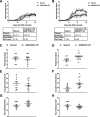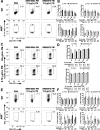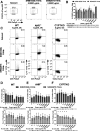Differential effects of diesel exhaust particles on T cell differentiation and autoimmune disease
- PMID: 30143013
- PMCID: PMC6109291
- DOI: 10.1186/s12989-018-0271-3
Differential effects of diesel exhaust particles on T cell differentiation and autoimmune disease
Abstract
Background: Exposure to particulate matter (PM) has been associated with increased incidence and severity of autoimmune disease. Diesel PM is primarily composed of an elemental carbon core and adsorbed organic compounds such as polycyclic aromatic hydrocarbons (PAHs) and contributes up to 40% of atmospheric PM. The organic fraction (OF) of PM excludes all metals and inorganics and retains most organic compounds, such as PAHs. Both PM and OF increase inflammation in vitro and aggravate autoimmune disease in humans. PAHs are known aryl hydrocarbon receptor (AHR) ligands. The AHR modulates T cell differentiation and effector function in vitro and in experimental autoimmune encephalomyelitis (EAE), a murine model of autoimmune disease. This study aims to identify whether the total mass or active components of PM are responsible for activating pathways associated with exposure to PM and autoimmune disease. This study tests the hypothesis that active components present in diesel PM and their OF enhance effector T cell differentiation and aggravate autoimmune disease.
Results: Two different diesel samples, each characterized for their components, were tested for their effects on autoimmunity. Both diesel PM enhanced effector T cell differentiation in an AHR-dose-dependent manner and suppressed regulatory T cell differentiation in vitro. Both diesel PM aggravated EAE in vivo. Fractionated diesel OFs exhibited the same effects as PM in vitro, but unlike PM, only one diesel OF aggravated EAE. Additionally, both synthetic PAH mixtures that represent specific PAHs found in the two diesel PM samples enhanced Th17 differentiation, however one lost this effect after metabolism and only one required the AHR.
Conclusions: These findings suggest that active components of PM and not total mass are driving T cell responses in vitro, but in vivo the PM matrix and complex mixtures adsorbed to the particles, not just the OF, are contributing to the observed EAE effects. This implies that examining OF alone may not be sufficient in vivo. These data further suggest that bioavailability and metabolism of organics, especially PAHs, may have an important role in vivo.
Keywords: Aryl hydrocarbon receptor; Autoimmune disease; Cytochrome P450; Diesel exhaust particles; Metabolism; Particulate matter; T cell differentiation.
Conflict of interest statement
Ethics approval
All animal studies were performed in accordance with protocols approved by the School of Medicine and Public Health Institutional Animal Care and Use Committee at the University of Wisconsin-Madison.
Consent for publication
Not applicable.
Competing interests
The authors declare that they have no competing interests.
Publisher’s Note
Springer Nature remains neutral with regard to jurisdictional claims in published maps and institutional affiliations.
Figures







Similar articles
-
The Aryl Hydrocarbon Receptor as an Immune-Modulator of Atmospheric Particulate Matter-Mediated Autoimmunity.Front Immunol. 2018 Dec 6;9:2833. doi: 10.3389/fimmu.2018.02833. eCollection 2018. Front Immunol. 2018. PMID: 30574142 Free PMC article. Review.
-
Polycyclic aromatic hydrocarbons (PAHs) present in ambient urban dust drive proinflammatory T cell and dendritic cell responses via the aryl hydrocarbon receptor (AHR) in vitro.PLoS One. 2018 Dec 21;13(12):e0209690. doi: 10.1371/journal.pone.0209690. eCollection 2018. PLoS One. 2018. PMID: 30576387 Free PMC article.
-
Ambient urban dust particulate matter reduces pathologic T cells in the CNS and severity of EAE.Environ Res. 2019 Jan;168:178-192. doi: 10.1016/j.envres.2018.09.038. Epub 2018 Oct 1. Environ Res. 2019. PMID: 30316103 Free PMC article.
-
Real-world PM extracts differentially enhance Th17 differentiation and activate the aryl hydrocarbon receptor (AHR).Toxicology. 2019 Feb 15;414:14-26. doi: 10.1016/j.tox.2019.01.002. Epub 2019 Jan 3. Toxicology. 2019. PMID: 30611761 Free PMC article.
-
Lung cancer associated with combustion particles and fine particulate matter (PM2.5) - The roles of polycyclic aromatic hydrocarbons (PAHs) and the aryl hydrocarbon receptor (AhR).Biochem Pharmacol. 2023 Oct;216:115801. doi: 10.1016/j.bcp.2023.115801. Epub 2023 Sep 9. Biochem Pharmacol. 2023. PMID: 37696458 Free PMC article. Review.
Cited by
-
Exposure to Environmental Toxins and Autoimmune Conditions.Integr Med (Encinitas). 2021 Apr;20(2):20-24. Integr Med (Encinitas). 2021. PMID: 34377090 Free PMC article.
-
Atmospheric particulate matter aggravates cns demyelination through involvement of TLR-4/NF-kB signaling and microglial activation.Elife. 2022 Feb 24;11:e72247. doi: 10.7554/eLife.72247. Elife. 2022. PMID: 35199645 Free PMC article.
-
The Aryl Hydrocarbon Receptor as an Immune-Modulator of Atmospheric Particulate Matter-Mediated Autoimmunity.Front Immunol. 2018 Dec 6;9:2833. doi: 10.3389/fimmu.2018.02833. eCollection 2018. Front Immunol. 2018. PMID: 30574142 Free PMC article. Review.
-
Occupational dust and chemical exposures and the development of autoimmune rheumatic diseases.Nat Rev Rheumatol. 2025 Mar;21(3):137-156. doi: 10.1038/s41584-024-01216-3. Epub 2025 Feb 5. Nat Rev Rheumatol. 2025. PMID: 39910253 Review.
-
The key player in the pathogenesis of environmental influence of systemic lupus erythematosus: Aryl hydrocarbon receptor.Front Immunol. 2022 Aug 30;13:965941. doi: 10.3389/fimmu.2022.965941. eCollection 2022. Front Immunol. 2022. PMID: 36110860 Free PMC article. Review.
References
-
- Institute HE . State of global air 2018. Boston: Health Effects Institute; 2018.
-
- Lerner A, Jeremias P, Matthias T. The world incidence and prevalence of autoimmune diseases is increasing. Int J Celiac Dis. 2015;3(4):151–5. 10.12691/ijcd-3-4-8.
-
- Health NIo: Progress in autoimmune disease research. National Institute of Health; 2005.
-
- Miller FW, Alfredsson L, Costenbader KH, Kamen DL, Nelson LM, Norris JM, et al. Epidemiology of environmental exposures and human autoimmune diseases: findings from a National Institute of Environmental Health Sciences expert panel workshop. J Autoimmun. 2012;39(4):259–71. http://www.ncbi.nlm.nih.gov/pubmed/22739348. - PMC - PubMed
Publication types
MeSH terms
Substances
Grants and funding
LinkOut - more resources
Full Text Sources
Other Literature Sources
Research Materials

